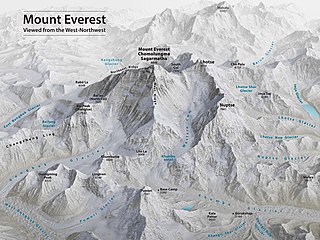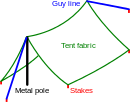Related Research Articles

Mount Everest is Earth's highest mountain above sea level, located in the Mahalangur Himal sub-range of the Himalayas. The China–Nepal border runs across its summit point. Its elevation of 8,848.86 m was most recently established in 2020 by the Chinese and Nepali authorities.

Sir Edmund Percival Hillary was a New Zealand mountaineer, explorer, and philanthropist. On 29 May 1953, Hillary and Sherpa mountaineer Tenzing Norgay became the first climbers confirmed to have reached the summit of Mount Everest. They were part of the ninth British expedition to Everest, led by John Hunt. From 1985 to 1988 he served as New Zealand's High Commissioner to India and Bangladesh and concurrently as Ambassador to Nepal.

The Rongbuk Glacier is located in the Himalaya of southern Tibet. Two large tributary glaciers, the East Rongbuk Glacier and the West Rongbuk Glacier, flow into the main Rongbuk Glacier. It flows north and forms the Rongbuk Valley north of Mount Everest. The famous Rongbuk Monastery is located at the northern end of the Rongbuk valley. Mount Everest is the source of the Rongbuk Glacier and East Rongbuk Glacier.

George Herbert Leigh-Mallory was an English mountaineer who participated in the first three British Mount Everest expeditions from the early to mid-1920s.
The goal of the Mallory and Irvine Research Expedition of 1999 was to discover evidence of whether George Mallory and Andrew Irvine had been the first to summit Mount Everest in their attempt of 8–9 June 1924. The expedition was instigated by British climber Graham Hoyland. It was organised by regular Everest expedition leader Eric Simonson and advised by researcher Jochen Hemmleb, with a team of climbers from the United States, the United Kingdom, and Germany. Hemmleb's investigations of reports of earlier sightings and photographs had led him to identify what he believed was the area in which Irvine's body lay, some distance below where his ice axe had been found by Percy Wyn-Harris on the expedition led by Hugh Ruttledge in 1933. The team hoped in particular to find a camera on Irvine's body which, had the pair been successful, should have contained a picture of the summit. After commencing the search on 1 May 1999, Conrad Anker mistakenly got off course and, surprisingly, found Mallory's body, not Irvine's.

The North Col refers to the sharp-edged pass carved by glaciers in the ridge connecting Mount Everest and Changtse in Tibet. It forms the head of the East Rongbuk Glacier.

Mount Everest is the world's highest mountain, with a peak at 8,849 metres (29,031.7 ft) above sea level. It is situated in the Himalayan range of Solukhumbu district, Nepal.

Conrad Anker is an American rock climber, mountaineer, and author. He was the team leader of The North Face climbing team for 26 years until 2018. In 1999, he located George Mallory's body on Everest as a member of a search team looking for the remains of the British climber. Anker had a heart attack in 2016 during an attempted ascent of Lunag Ri with David Lama. He was flown via helicopter to Kathmandu where he underwent emergent coronary angioplasty with a stent placed in his proximal left anterior descending artery. Afterwards he retired from high altitude mountaineering, but otherwise he continues his work. He lives in Bozeman, Montana.
Russell Reginald Brice is a New Zealand mountaineer. He was the owner/manager of Himex, a climbing expedition company. He has summited Cho Oyu seven times, Himal Chuli and Mount Everest twice, as well as Manaslu in October 2010, which was his 14th summit of an 8000 m peak.

David Allen Hahn is an American mountaineer, ski patroller and journalist. In May 2013, he reached the summit of Mount Everest for the 15th time—at the time, this was the most summits for a non-Sherpa climber, according to Outside Magazine contributor and climber Alan Arnette. His record was surpassed by Kenton Cool in 2022. Among Hahn’s other notable accomplishments are his 39 summits of Vinson Massif, Antarctica’s highest mountain. He has reached the summit of Denali in Alaska, North America’s highest peak, 25 times over the course of 37 expeditions.

The 1924 British Mount Everest expedition was—after the 1922 British Mount Everest expedition—the 2nd expedition with the goal of achieving the first ascent of Mount Everest. After two summit attempts in which Edward Norton set a world altitude record of 8,572.8 metres (28,126 ft), the mountaineers George Mallory and Andrew "Sandy" Irvine disappeared on the third attempt. Their disappearance has given rise to the long-standing speculation of whether or not the pair might – under a narrow set of assumptions – have reached the summit. Mallory's body was found in 1999 at 8,156 metres (26,760 ft), but the resulting clues did not provide any conclusive evidence as to whether the summit was reached.
Barry Chapman Bishop was an American mountaineer, scientist, photographer and scholar. With teammates Jim Whittaker, Lute Jerstad, Willi Unsoeld and Tom Hornbein, he was a member of the first American team to summit Mount Everest on May 22, 1963. He worked for the National Geographic Society for most of his life, beginning as a picture editor in 1959 and serving as a photographer, writer, and scientist with the society until his retirement in 1994. He was killed in an automobile accident near Pocatello, Idaho later that year.

The 1922 British Mount Everest expedition was the first mountaineering expedition with the express aim of making the first ascent of Mount Everest. This was also the first expedition that attempted to climb Everest using bottled oxygen. The expedition attempted to climb Everest from the northern side out of Tibet. At the time, Everest could not be attempted from the south out of Nepal as the country was closed to Western foreigners.

The 1953 British Mount Everest expedition was the ninth mountaineering expedition to attempt the first ascent of Mount Everest, and the first confirmed to have succeeded when Tenzing Norgay and Edmund Hillary reached the summit on 29 May 1953. Led by Colonel John Hunt, it was organised and financed by the Joint Himalayan Committee. News of the expedition's success reached London in time to be released on the morning of Queen Elizabeth II's coronation, on 2 June that year.

Norman Gunther Dyhrenfurth was a German-Swiss-American mountaineer and filmmaker. He was the leader of the successful American Mount Everest Expedition of 1963, which placed six climbers on the summit.

The 1933 British Mount Everest expedition was, after the reconnaissance expedition of 1921, and the 1922 and 1924 expeditions, the fourth British expedition to Mount Everest and the third with the intention of making the first ascent.

The Mount Everest climbing season of 2017 began in spring with the first climbers reaching the top on May 11, from the north side. The first team on the south side reached the top on May 15. By early June, reports from Nepal indicated that 445 people had made it to the summit from the Nepali side. Reports indicate 160–200 summits on the north side, with 600–660 summiters overall for early 2017. This year had a roughly 50% success rate on that side for visiting climbers, which was down from other years. By 2018, the figure for the number of summiters of Everest was refined to 648. This includes 449 which summited via Nepal and 120 from Chinese Tibet.
References
- 1 2 Schaneman, Bart (2023-10-19). "Johnson Outdoors to Exit Eureka Business, Focus on Jetboil". thedaily.outdoorretailer.com. Retrieved 2024-01-15.
- ↑ name="ReferenceA" DeMartine, Robert B. to Abraham Lincoln School, Binghamton, NY. (1966-09-15).
- ↑ Johnson Worldwide Associates North America (1994). "Eureka Tent and Awning Opens in Binghamton," The Sporting Gazette. I: 2.
- ↑ "Eureka! History". outdoorinov8.com. Compass: Charting the Evolution of Outdoor Gear. Retrieved 26 August 2023.
- ↑ Watson, Jr., Thomas J. (2000). Father, Son & Co.: My Life at IBM and Beyond. New York: Bantam: 157. ISBN 0-553-38083-4.
- ↑ "DeMartine Elected Eureka President." Canvas Products Review (May 1959): 12.
- 1 2 ""About Eureka!"". Archived from the original on 2008-06-12. Retrieved 2008-06-16.
- ↑ Platsky, Jeff (1982-10-03). "Eureka treks for tent sales," The Sunday Press (Binghamton, NY). 8E.
- ↑ DeMartine, Robert (1973). "Eureka Tent Sets 78-Year Record." The Binghamton Press.
- ↑ "Boy Scout Tent". 6 January 2010.
- ↑ Basler, George (2017-09-08). "Vestal businessman, 72, led by example". Press & Sun-Bulletin . Binghamton, New York. Retrieved 26 August 2023.
- ↑ National Export Expansion Council (U.S.) (1975). National and Regional Export Expansion Councils Directory. United States Department of Commerce. p. 61. Retrieved 26 August 2023.
Jack C. Abert , President; Camp Trails Company 4111 West Clarendon Avenue Phoenix , Arizona 85019
- ↑ Demo, Lori (1981-04-17). "DeMartine retires at Johnson Camping," The Evening Press (Binghamton, NY). 9-B.
- 1 2 3 4 5 “About Eureka!: History.” , Eureka!. Retrieved on 2008-06-06.
- ↑ Frazier, Tom (1987-10-14). "Johnson Camping’s owner pitches public tent," The Press & Sun Bulletin (Binghamton, NY). 8B.
- ↑ "Johnson Worldwide Associates, Inc. - Cmp". www.johnsonoutdoors.com/us/locations. Retrieved 2024-02-04.
- ↑ Woods, Willard (1991-07-04). "Bass Pro workers rise and shine for early visit," The News-Leader (Springfield, MO).
- ↑ Hillary, Sir Edmund (1954-07). "The Conquest of the Summit," The National Geographic Magazine. CVI: 1: 45-62.
- 1 2 3 Milledge, James S. (2007-10-05). "The Silver Hut Expedition." (speech, The Mountain and Wilderness World Congress, Aviemore, Scotland).
- 1 2 Blanchard, Robert L. to Mr. W. Whittaker, Redmond, WA. (1962-06-05).
- ↑ Barry C. Bishop to Robert Blanchard, New York, NY. (1962-09-21).
- ↑ Dyhrenfurth, Norman G. (1963-10). "Six to the Summit: America’s first Everest expedition takes the mountain by storm," National Geographic. 124:4: 464.
- ↑ “The Day Mallory Was Found,”, NOVA Online Adventure. (2000-11). Retrieved: 2008-05-13.
- ↑ “5th Season Expedition Tent Design Diary: Trade Show Revelations,”, Eureka! Camping. Retrieved: 2004-05-25.
- 1 2 Platsky, Jeff (2001). "Conklin-made tents heading for Mt. Everest," The Binghamton Press.
- ↑ “Essay: Home Sweet Home in the Eureka at C6,”, International Mountain Guides. Retrieved: 2008-05-13.
- ↑ Simonson, Eric (2001-05-28). “Giving Thanks,”, International Mountain Guides. Retrieved: 2008-05-13.
- ↑ “Exclusive Tent Provider Named for Second Mallory & Irvine Research Expedition,” Archived 2004-08-03 at the Wayback Machine , Investor Relations, Johnson Outdoors, Inc. (2001-01-10). Retrieved: 2008-05-13.
